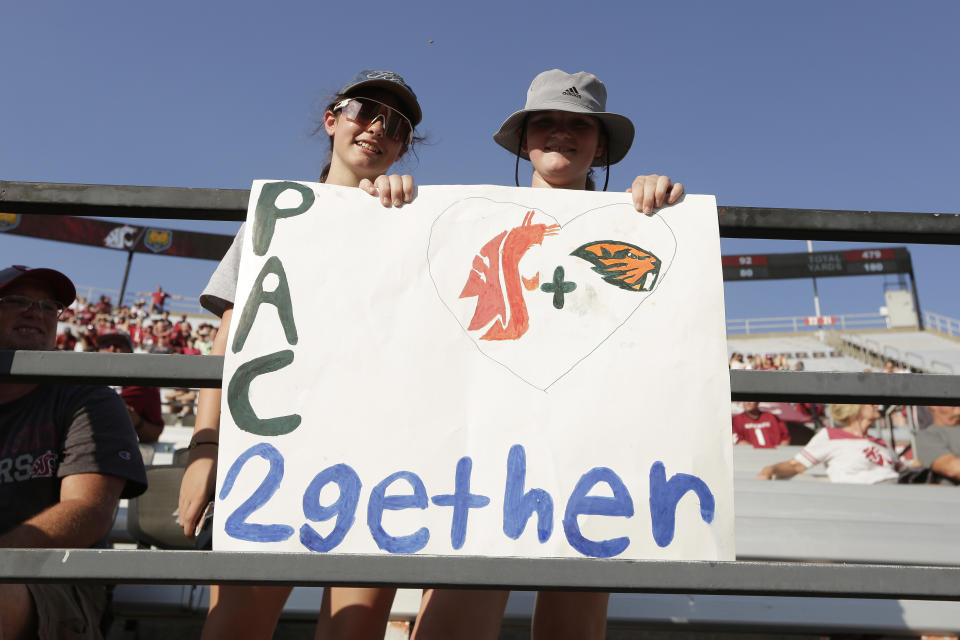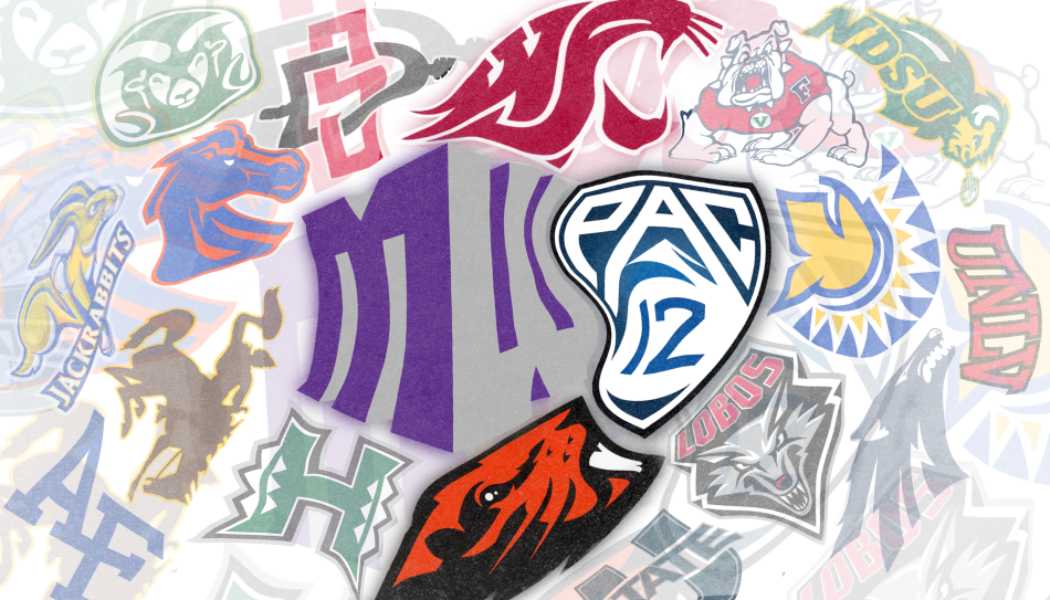On the Palouse this Saturday night, the Pac-2 Bowl will unfold.
The remaining two members of the imploded Pac-12 conference, Oregon State and Washington State, meet in a game of top-25 ranked teams. Amid a slew of giant matchups this weekend, the Pac-2 battle is sliding beneath the hubbub despite the stakes.
The Cougars are 3-0, ranked No. 21 and have taken down Wisconsin with FCS-turned-Power Five dual-threat quarterback Cameron Ward. The Beavers are 3-0, ranked No. 14 and have allowed 33 points in three games with former Clemson QB D.J. Uiagalelei manning the offense.
But it’s off the field where so much interest in these two programs lies. As they team up for a court fight over the Pac-12’s survival, their future conference affiliation hangs in doubt.
Will they dissolve the Pac-12 and join the Mountain West?
Will they merge with the Mountain West under the Pac-12 banner to preserve the league and its assets?
Will they rebuild the Pac-12 by plucking other Group of Five members?
Or … Will they do something unconventional, creative and, some might say, altogether eccentric. Will they leap with both feet into a pool of uncertainty, overhaul how college conferences are structured and remake the industry’s long-standing model?
“We have to think differently,” said one Mountain West athletic director who wished to remain anonymous. “We’re always trying to fit things in a box and we are always late to the party. How do we get in front of this?”
The Pac-2’s answer, some believe, should be to create a two-conference partnership with the Mountain West around a model similar to European soccer leagues, using a relegation and promotion system for football (and potentially other sports).
The goal is to create high-stakes matchups, scheduling alliances and a points system to fuel interest and excitement in college football’s lower tier. In theory, such a system would make these lower-resourced football programs more appealing to linear and streaming partners in a world where the industry is leaning on such income to survive.
“It’s time we admit what college football is: an entertainment product,” said one Mountain West administrator.
Officials who spoke to Yahoo Sports for this story did so under the agreement of anonymity because of the sensitivity of the discussions between the remaining two Pac-12 schools and those from the Mountain West.
While the sides continue to deliberate over options, there may not be a resolution for weeks, until a Washington county court resolves a dispute between the Pac-2 and the other 10 schools over control of the league’s decision-making powers. That includes control over the conference’s liabilities and assets, two important factors in determining the future course of action for the Beavers and Cougars.
The relegation/promotion idea is only an idea, for now. While the concept has been explored by many officials in both the Pac-2 and Mountain West, it is only one of a host of possible options in the early stages of examination.
“It’s kind of brilliant,” said one Group of Five athletic director. “The reason it wouldn’t happen is that people wouldn’t enter into something if they have the risk of losing something big [like being relegated]. But the economics could make sense.”
The first step
The idea isn’t completely out of left field.
Developing an English soccer-type system in college football is a long-talked-about endeavor for the powerhouse football programs who seem to be consolidating into a couple of leagues. The thought by many in college sports is that the top 30-50 most valuable college programs will break away and form a semi-professional division that may one day feature such relegation and promotion.
But what if the other guys did it before them?
Preserving two separate conferences is maybe the most important part of this concept. The Mountain West and Pac-2 would strike a partnership around a relegation system for football and be managed by a single commissioner, though their membership may fluctuate — at least in football — on an annual or biannual basis.
The conferences, if kept separate and recognized as such by both the NCAA and College Football Playoff, would:
-
Retain the millions of dollars in assets in existence within the Pac-12, including at least $50 million in NCAA tournament basketball shares, more than $40 million in reserves and whatever else (Pac-12 network infrastructure, etc.).
-
Retain automatic qualifying spots in NCAA championship tournaments for each league’s champion in all sports except football.
-
Retain revenue distribution from the CFP for each league (a real question).
The idea starts with the Pac-12 and Mountain West each having at least eight members for a total of 16 teams. Think of it as a Pac-12 division and a Mountain West division under the umbrella of this football-relegation partnership.
As it currently stands, the two leagues combine for 14 football-playing members. For regional purposes as well as historic success and resources, North Dakota State and South Dakota State are obvious expansion targets.
Each year or two, two teams from each conference are relegated and promoted: two promoted from the Mountain West to the Pac-12 and two relegated from the Pac-12 to the Mountain West.
To begin Year 1 in this concept, Oregon State and Washington State remain in the Pac-12. The two expansion additions agree to join by starting in the lower tier, the Mountain West. How are the 12 other schools divided — six to the Pac-12 and six the Mountain West? Is it by conference standings over the past decade or two? Is it by overall revenue figures? Is it a made-for-TV NBA-style lottery drawing?
However it’s done, things could get messy politically.
The scheduling
The goal here is to create interesting, high-stakes matchups for fan experience and television purposes, relying on the previous season’s standings and the current season’s standings to orchestrate pairings.
A team’s schedule would include two non-conference opponents, seven intra-conference games and three crossover games. For instance, in Year 1, Oregon State plays two non-conference games that they schedule, seven games against all the other Pac-12 teams and three games against those from the Mountain West.
Previous season results determine a pecking order to arrange matchups, such as:
– a Week 1 rematch of the previous year’s Pac-12 championship game.
– a Week 1 game between the two teams promoted from the Mountain West to the Pac-12 and two teams relegated from the Pac-12 to the Mountain West.
– a Bracket Buster Weekend in early to mid-November, where pairings are determined two weeks prior and are based off of current standings with the intent on arranging compelling, crossover matchups.
The entire season builds up to a crescendo of a final week that features three games:
– A Relegation Game between the sixth- and seventh-placed teams in the Pac-12. The loser is relegated to the Mountain West. The eighth-place finisher in the regular season is automatically relegated.
– A Promotion Game between the second- and third-placed teams in the Mountain West. The winner is promoted to the Pac-12. The regular-season champion of the Mountain West is automatically promoted to the Pac-12.
– The Pac-12 championship game, where the winner has a significant chance to advance to the newly expanded College Football Playoff.

The money
Invariably, the differentiating factor from one conference to the next is money.
In theory, the conferences would enter into a joint media rights deal that distributes a higher base revenue to teams in the Pac-12 and a lower base revenue to teams in the Mountain West, with an incentive structure featuring bonuses for a school’s finish in the standings.
For instance, if the leagues strike a media rights deal worth $100 million annually, Pac-12 programs would earn 60% ($7.5M per school) while Mountain West schools earn the other 40% ($5M per school). Schools could receive bonuses for winning each league and being promoted from the Mountain West to the Pac-12.
This is where the real problem lies, said one conference administrator. With relegation, budgets will change, dipping by as much as $3-5 million a year. That’s an issue for athletic directors in annual budget projections. There must be a balance struck in the base distribution that allows for annual budget projections.
“If a school is getting $15 million this year, they budget for $15 million next year,” said the conference official. “Well, if we are relegated, we can’t do that.”
There are plenty more issues and unresolved matters with this concept.
For instance, what happens to men’s and women’s basketball and Olympic sports? One administrator suggests relegation in each sport. Another believes that relegation should only extend to the football and basketball teams, leaving the Olympic sports to create a regionally based schedule among the 16 teams.
After all, one athletic director said, football is responsible for at least 90% of a media rights deals anyhow.
One of the key questions: Will the NCAA and CFP even consider the two separate conferences?
How the standings are administered is another unresolved issue. The natural way is by winning percentage and tiebreakers. But what if college football begins using a soccer-style points system?
Three points for any win. One point for an overtime loss. Zero for any other loss.
Should a bonus point be given if a Mountain West team beats one from the Pac-12?
Questions linger. Matters are unresolved.
But as the Pac-2 Bowl unfolds on Saturday night, the two programs, off of the field, have a chance to dive into an unconventional, creative and, yes, maybe eccentric model.
Will they do it?
“Everything is on the table,” said one high-placed source with knowledge of discussions between the leagues. “We’re looking at a lot of options. This one included.”
Services Marketplace – Listings, Bookings & Reviews









